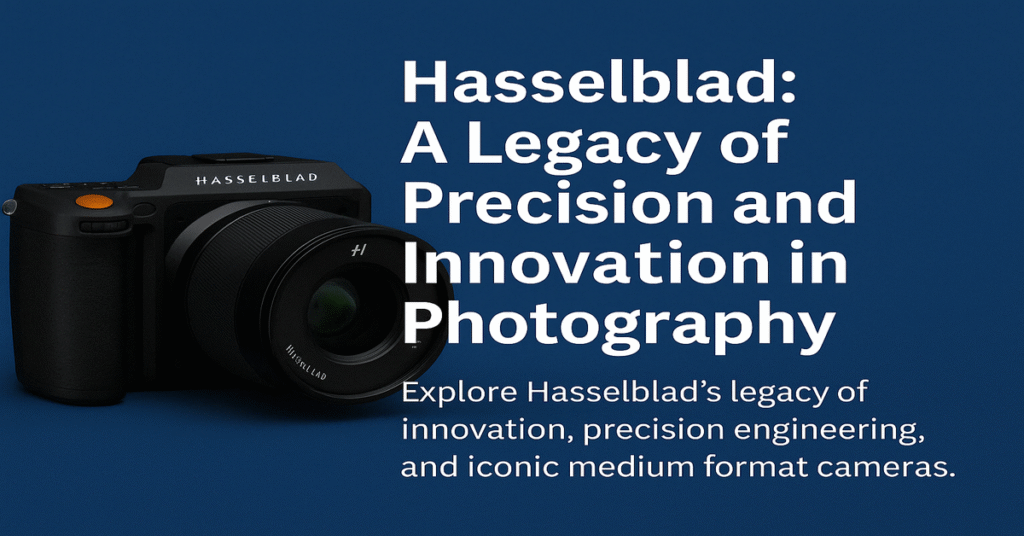Hasselblad, the Swedish camera manufacturer, has long been synonymous with precision engineering, exceptional image quality, and a storied history that intertwines with some of humanity’s most significant moments. From its humble beginnings in the 19th century to its pivotal role in space exploration and its continued innovation in the digital age, Hasselblad has consistently set the benchmark for medium format photography.
Early History and Foundation
Origins in Gothenburg
Founded in 1841 by Fritz Wiktor Hasselblad in Gothenburg, Sweden, the company initially operated as a trading firm, F.W. Hasselblad & Co., dealing in a variety of imported goods. It wasn’t until the early 20th century that the company ventured into photography, establishing a division dedicated to photographic products, which laid the groundwork for its future in camera manufacturing.about photography+1Wikipedia, l’enciclopedia libera+1
Transition to Camera Manufacturing
The onset of World War II marked a turning point for Hasselblad. In 1941, the Swedish military commissioned the company to produce a camera for aerial reconnaissance, leading to the development of the HK7, Hasselblad’s first camera. This endeavor not only showcased the company’s engineering prowess but also ignited its passion for camera design and manufacturing.Hasselblad+1about photography+1
The Birth of the Hasselblad Camera
Introduction of the 1600F
In 1948, Victor Hasselblad introduced the 1600F, the world’s first single-lens reflex (SLR) medium format camera with interchangeable lenses, film magazines, and viewfinders. This modular design revolutionized photography by offering unprecedented flexibility and image quality, setting a new standard for professional cameras.Wikipedia, l’enciclopedia libera+2hasselbladfoundation.org+2Hasselblad+2
The 500 Series
Building on the success of the 1600F, Hasselblad launched the 500C in 1957, featuring a leaf shutter system that allowed for flash synchronization at all shutter speeds. The 500 series became iconic, widely adopted by professional photographers for its reliability, image quality, and adaptability.Wikipedia, l’enciclopedia libera+3Hasselblad+3Hasselblad+3
Hasselblad in Space
Partnership with NASA
Hasselblad’s reputation for precision and durability caught the attention of NASA in the 1960s. Astronaut Walter Schirra, an avid photographer, suggested using a Hasselblad 500C for space missions. NASA collaborated with Hasselblad to modify the camera for space conditions, resulting in a lightweight, simplified version suitable for zero-gravity environments.WIRED+1Wikipédia, l’encyclopédie libre+1
Capturing Iconic Moments
Hasselblad cameras were aboard during the Apollo missions, capturing some of the most iconic images in history, including the first steps on the Moon. These photographs not only documented humanity’s achievements but also solidified Hasselblad’s legacy in the annals of space exploration.WIRED
Transition to Digital Photography
Embracing Digital Innovation
As the photography industry shifted towards digital technology, Hasselblad adapted by introducing digital backs for its medium format cameras. In 2002, the company launched the H1, its first medium format camera designed for both film and digital use, marking its commitment to embracing digital innovation while maintaining its core values of image quality and precision.WIRED+1Hasselblad US+1
The H System
The H System evolved to include fully integrated digital medium format cameras, such as the H3D and H4D series, offering photographers high-resolution sensors, advanced autofocus systems, and the renowned Hasselblad image quality. These cameras catered to professional photographers demanding the utmost in detail and color accuracy.Hasselbladabout photography+1Hasselblad+1
The X System: Compact Medium Format
Introduction of the X1D
In 2016, Hasselblad unveiled the X1D-50c, the world’s first mirrorless medium format camera. Combining the image quality of medium format with the portability of mirrorless design, the X1D-50c featured a 50-megapixel CMOS sensor, a sleek Scandinavian design, and user-friendly interface, appealing to a new generation of photographers.WIRED+10Wikipedia+101kindphotography.com+10WIRED+1Hasselblad US+1
Advancements with the X2D 100C
Building on the success of the X1D, Hasselblad introduced the X2D 100C, boasting a 100-megapixel sensor, in-body image stabilization, and a high-resolution electronic viewfinder. This camera exemplified Hasselblad’s commitment to innovation, delivering unparalleled image quality in a compact form factor.Gadget Flow+5Hasselblad+5Fstoppers+5
Hasselblad’s Commitment to Quality
Handcrafted Excellence
Each Hasselblad camera is meticulously assembled by hand in Sweden, ensuring the highest standards of quality and precision. This dedication to craftsmanship reflects the company’s philosophy of producing tools that enable photographers to capture images with exceptional clarity and detail.WIRED
Collaboration with Zeiss
Hasselblad’s long-standing partnership with Carl Zeiss has been instrumental in delivering lenses renowned for their sharpness, color fidelity, and minimal distortion. This collaboration has contributed significantly to Hasselblad’s reputation for optical excellence.
Hasselblad Today and Beyond
Today, Hasselblad continues to innovate, offering a range of medium format cameras that cater to both professionals and enthusiasts. With a focus on combining traditional craftsmanship with modern technology, Hasselblad remains at the forefront of photographic excellence, inspiring photographers worldwide to push the boundaries of their creativity.
Conclusion
Hasselblad’s journey from a Swedish trading company to a global icon in photography is a testament to its unwavering commitment to quality, innovation, and the art of image-making. By continually adapting to technological advancements while honoring its rich heritage, Hasselblad has secured its place as a revered name in the world of photography.

